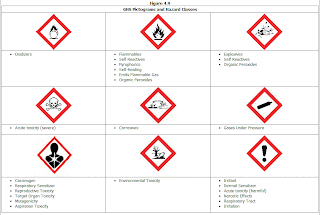I'll get back to the RCRA "In The Beginning" posts in a bit. They involve reading the Federal Register and that ain't a lot of fun to do on a holiday weekend.
I'm in the process of teaching a bunch of military guys. Each year I try to change it up a bit and work on a different "theme." This year we are looking at the DoD's new "Chemical Comparability System" which is a method of determining which chemical products can be stored together. As part of this training I developed an exercise whereby they break into groups and using MSDS and labels, place the chemical container into the correct Hazard Characteristic Code "HCC" group.
One of the chemicals I chose uses the new Globally Harmonized System's (GHS) "Safety Data Sheet" or "SDS" which is going to replace the OHSA "MSDS." Gotta love acronyms to be in this business!
This particular SDS also gave the new GHS label that was to appear on the container. "Cool," I thought. "I'll put that label on my mock chemical container and see if they can determine the HCC." Only to make it challenging, I did not give them the SDS.
Now the way the DOD's HCC is designed is to have one of 63 HCCs assigned to every chemical product used by the military so they can be placed into one of 10 primary Hazardous Storage Areas and then segregated further - if required.
The goal is to have this code placed on the MSDS/SDS in the "Physical/Chemical Properties" section.
 |
| HCC is identified by supplier as "D3" |
If the MSDS/SDS does not identify the HCC, the person can then look at the DOT transportation label and assign it a "suggested temporary HCC:"
It's not a bad system, but it relies on the HCC being correctly assigned by the supplier (something the exercise superstitiously discovered) or the container has the DOT shipping label. But small containers are often shipped in a larger shipping container and do not have the DOT label when removed and placed into facility storage.
In this case, the container must be labeled to meet OSHA standards (U.S.) - which does not require a pictograph - and soon the new GHS label standards - which does.
 |
| OSHA |
And this is where the breakdown of communication starts. Can a regular Joe/Jane determine what the hazard of a chemical is from the new GHS label? According to my exercise, 3 out of the 4 teams can, but it is not because of the label.
Next post: GHS...We Have A Problem Here - Part 2
.


Jeff,
ReplyDeleteI have put together a collection of GHS resources that can be downloaded at (www.GHSKit.com). It is 100% free. The kit includes:
-Introduction to GHS Poster
-Make shift secondary container labels
-version 3 & 4 of the UN Purple Book
-OSHA Final Rule aligning the HCS with GHS
I am in the process of adding some additional resources to the kit.
I hope you find it helpful!
-Alfonso
419-287-6832
a.lerma@online-msds.com
www.online-msds.com
Monarchgraphics is your trusted source for Ghs Supplier Label. Our precision-engineered labels ensure compliance and safety in hazardous chemical handling. With advanced printing technology and a commitment to quality, Monarchgraphics delivers labels that meet regulatory standards and prioritize workplace safety. Trust Monarchgraphics for reliable GHS Supplier Labels that keep your operations secure.
ReplyDelete